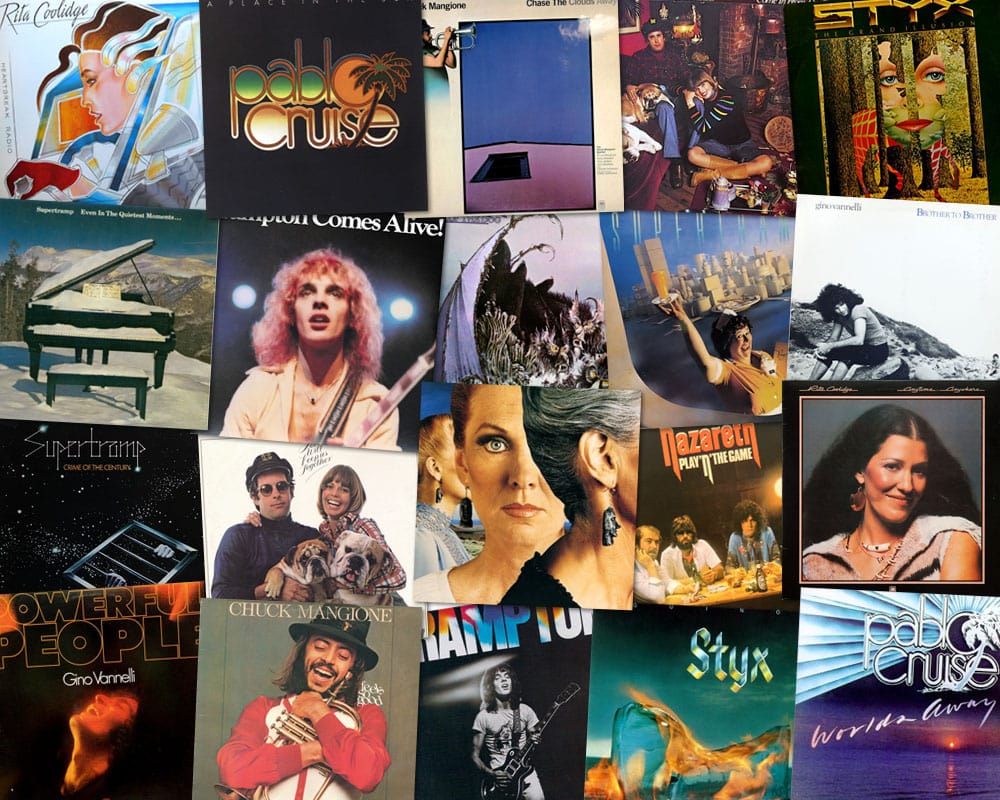Our last installment (Issue 161) found A&M in transition, moving away from the vocal and instrumental pop and vocal sounds into some British rock and domestic rock and folk acts, as well as the anomaly that was the Carpenters. A&M at this point was on a roll. Having million-selling albums from artists like Yusuf/Cat Stevens and Joe Cocker, and a continuing run of hit singles and albums by the Carpenters, the label had the financial footing and higher profile needed to attract talent they could develop and sell records. (Part One of this series appears in Issue 160.)
Growing up in the 1970s, nearly everyone I knew with a rock collection had a copy of this 2-LP set: formerly of Humble Pie, Peter Frampton set out on his own, recording four albums that sold in moderate numbers until he found his biggest success with the double-live album Frampton Comes Alive! in 1976. Three of the tracks from the album were released as hit singles, the album topped the Billboard 200 album chart for ten weeks, and it was the best-selling album of 1976. “Show Me The Way” and “Do You Feel Like We Do” featured the “talk box” effect on his guitar.
Named after a town in Pennsylvania (from the first line of The Band’s classic song “The Weight”), the Scottish rock band Nazareth was one of the overseas bands A&M licensed for release in the US. In 1975, the band’s sixth album Hair of the Dog proved to be their most successful, with the title track becoming a staple on classic rock radio. Their biggest hit, though, was a song once performed by the Everly Brothers – “Love Hurts.” The song peaked at Number 8 on the Billboard Hot 100, and reached Number 1 in many other countries.
One British band signed to A&M did not see much success until their breakthrough album, Crime of the Century, was released in 1974. This Supertramp album made it to the Top 40 in the US, while reaching Number 6 in both the UK and Canada. It’s also an audiophile favorite for its exceptional sound quality. Below is the band’s first hit single, “Dreamer.” Supertramp would achieve major success with their 1979 album Breakfast in America, which topped the Billboard 200 for six weeks and sold millions of copies worldwide.
One way to get your foot in the door at A&M was to send in a demo tape. Another was to stalk the front of the A&M lot at 1416 North LaBrea Avenue for hours, and chase the label’s owner down when he appeared outside the building. While Alpert and the A&M lot security guard were alarmed about being rushed at the gates, the young musician/singer from Montreal begged Alpert to hear a few of his songs. After returning later that afternoon to play a few of his compositions for Alpert, the label signed Canadian singer Gino Vannelli, and Alpert produced Vannelli’s first album, Crazy Life. Vannelli’s last album for A&M would be his biggest, spawning the Adult Contemporary radio staple “I Just Wanna Stop.” This song, “People Gotta Move,” is from his second album Powerful People, released in 1974.
In the late 1960s in Chicago, a young pianist and accordion player, Dennis DeYoung, joined the basement band of twin brothers Chuck and John Panozzo, calling themselves the Tradewinds. Afterward, they met guitar player John Curulewski while attending college in that city, and renamed themselves TW4. Later, James Young joined the group, and they settled on the name Styx. A chance gig attended by a talent scout got the band signed with Wooden Nickel for four records (scoring a hit with “Lady”) before moving over to A&M. Curulewski would leave the band after their 1975 A&M debut Equinox, but they lucked out in finding replacement Tommy Shaw, a young guitarist/singer from Alabama. Over the course of several albums, they would produce many top-selling albums and singles, including a Number 1 hit with “Babe” and the Number 1 album Paradise Theater. Here is a favorite of mine, “Lorelei,” from Equinox.
Proving that pop music wasn’t dead, a husband/wife duo took a Neil Sedaka song to the top of the charts for four weeks in 1975. Captain & Tennille were Toni Tennille and Daryl Dragon (son of legendary conductor Carmen Dragon, brother of Dennis Dragon of the Surf Punks). “Love Will Keep Us Together” not only had an impressive chart run, it was the top single of 1975, and won a Record of the Year Grammy award for them as well as a Grammy nomination for Song of the Year for songwriters Neil Sedaka and Howard Greenfield. It was one of the last songs the two composed together.
The days of offering purely instrumental music like the Tijuana Brass were pretty much in the past for A&M, but the label still managed to squeak out something every now and then that caught the ear of the record-buying public. Trumpet and flugelhorn player Chuck Mangione, who at first was a jazz musician and a member of Art Blakey’s Jazz Messengers, recorded a handful of early albums on Riverside with his brother, keyboardist Gaspare (Gap) Mangione in the early ’60s. He then recorded with larger ensembles for Mercury, then signed with A&M in 1975 and recorded nine albums for the label. His fourth A&M album would be the charm – the title track from the 1977 album Feels So Good would reach Number 4 on the Billboard Hot 100 chart, and hit Number 2 on the Billboard 200 album chart.
Another 1977 album would bring A&M even more success. Rita Coolidge recorded 14 albums for A&M, but her best-selling effort was Anytime…Anywhere, which featured three Billboard top 20 hits – covers of the Boz Scaggs song “We’re All Alone,” the Temptations’ “The Way You Do the Things You Do,” and a remake of the Jackie Wilson hit “(Your Love Has Lifted Me) Higher and Higher” that made it all the way to Number 2 on the Hot 100.
A&M was no stranger to soft rock and California pop, and Pablo Cruise could almost be considered an update of the type of music the label released in the ’60s. Having signed to the label in 1975, The group found their third album, A Place in the Sun, to be their commercial breakthrough with the featured hit “What’cha Gonna Do?,” but their biggest success was achieved with their next release, Worlds Away, featuring the hit singles “Don’t Want to Live Without It” and “Love Will Find a Way.”
Although A&M was firmly established in the rock and pop groove, the label also had success in other musical genres. We will look at A&M’s releases in soul, funk and R&B in our next installment, and in the following one, examine the winds of change that took A&M into the 1980s.



